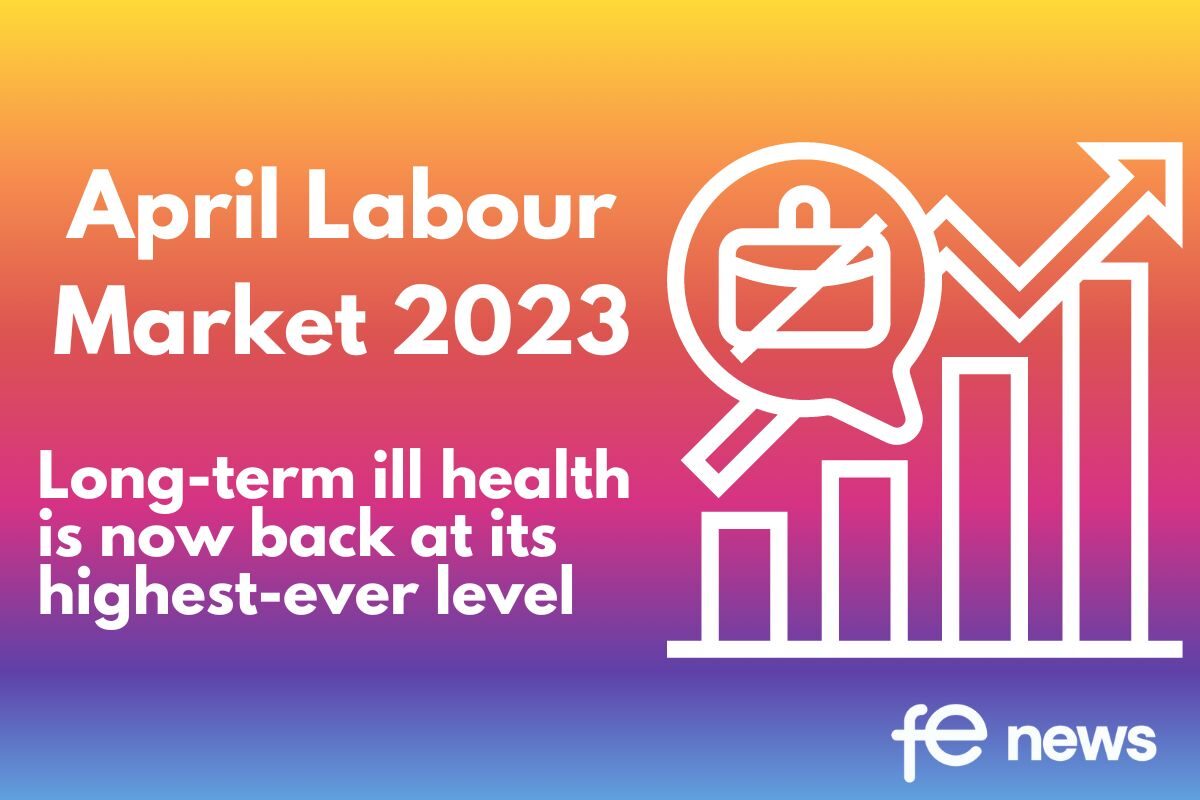April Labour Market 2023- Sector Response

Due to a combination of weak growth, more out of work with ill health and fewer older people in work. Economic inactivity due to long-term ill health is now back at its highest-ever level – 2.53 million.
Labour Market April 2023- Main Points:
The UK employment rate was estimated at 75.8% in December 2022 to February 2023, 0.2 percentage points higher than September to November 2022. The increase in employment over the latest three-month period was driven by part-time employees and self-employed workers.
The timeliest estimate of payrolled employees for March 2023 shows another monthly increase, up 31,000 on the revised February 2023 figures, to 30.0 million.
The unemployment rate for December 2022 to February 2023 increased by 0.1 percentage points on the quarter to 3.8%. The increase in unemployment was driven by people unemployed for up to six months.
The economic inactivity rate decreased by 0.4 percentage points on the quarter, to 21.1% in December 2022 to February 2023. The decrease in economic inactivity during the latest three-month period was largely driven by people aged 16 to 24 years. Looking at economic inactivity by reason, the quarterly decrease was largely driven by people inactive because they are students.
In January to March 2023, the estimated number of vacancies fell by 47,000 on the quarter to 1,105,000. Vacancies fell on the quarter for the ninth consecutive period and reflect uncertainty across industries, as survey respondents continue to cite economic pressures as a factor in holding back on recruitment.
Growth in average total pay (including bonuses) was 5.9% and growth in regular pay (excluding bonuses) was 6.6% among employees in December 2022 to February 2023. Average regular pay growth for the private sector was 6.9% in December 2022 to February 2023 and 5.3% for the public sector. The difference between the private and public sector growth rates has narrowed in recent months. In real terms (adjusted for inflation), growth in total and regular pay fell on the year in December 2022 to February 2023, by 3.0% for total pay and by 2.3% for regular pay. A larger fall on the year for real total pay was last seen in February to April 2009, when it fell by 4.5%, but it still remains among the largest falls in growth since comparable records began in 2001.
There were 348,000 working days lost because of labour disputes in February 2023, up from 210,000 in January 2023. Over three-fifths of the strikes in February were in the education sector.
Click here to read the complete labour report for April 2023.
Read last month’s Labour market and sector response by clicking here.
Resolution Foundation’s Analysis: Young return to work but old and sick do not
The UK workforce expanded in the three months to February, driven by young people leaving full-time education and moving into work, but the longer-term problem of rising ill-health continues to worsen, the Resolution Foundation said in response to the latest ONS labour market statistics today (Tuesday).
The UK workforce continued to expand in recent months, with employment up 170,000 on the quarter, and economic inactivity down 230,000. The fall in inactivity was driven by full-time students: the number of people inactive due to being a full-time student was down 180,000 on the quarter.
The labour market has loosened overall, with short-term unemployment (up to 6 months) rising by 52,000 to above normal pre-pandemic levels, and vacancies falling by 47,000 on the quarter.
Less encouragingly, inactivity among older workers aged 50-64 remains high – up 298,000 on pre-pandemic levels – while the number of people inactive due to ill-health rose to a record high of over 2.5 million. Reversing this trend – which predated the pandemic – is a huge priority that is likely to take years to address, says the Foundation, and a key test of the new Health and Disability White Paper.
Nominal pay growth strengthened in February, driven by the gap between public-sector (5.3 per cent) and private sector (6.1 per cent) pay growth closing. However, with inflation still at double digits, pay packets continue to shrink in real terms.
IES Analysis
Today’s figures show continued improvement in the labour market – with employment up, economic inactivity down and unemployment broadly flat. Employment is almost back to where it was around this time last year, although it remains around 0.8 percentage points higher – and economic inactivity 0.9 points lower – than on the eve of the pandemic.
Today’s pay data is broadly in line with (slightly better than) figures for last month, with annual pay growth at around 7%. This remains very high by historic standards, but not enough to offset stubbornly high inflation. There is significant uncertainty on both pay and inflation in the coming months, but if inflation falls faster than pay (which is plausible) then we may start to see real pay recover later in the year.
Worryingly however, lower economic inactivity is still masking very large rises in the number of people out of work due to long-term ill health – which has hit a new record, at 2.53 million – and more young people neither in full-time education nor employment (which is back above one million). Long-term unemployment may also be starting to tick up again.
Today’s briefing also includes analysis of changes in part-time, full-time, employee and self-employed work for men and women, and illustrates that recent improvements in employment are being driven by a recovery in employment for men, particularly in part-time work and self-employment. Interestingly, the number of people in part-time work because they cannot find a full-time job is falling (as is the number in temporary work because of a lack of permanent jobs).
All told then, today’s figures are broadly positive but still suggest that many of those who are most disadvantaged in the labour market are struggling the most to get into work even as the economy continues to create jobs. This in turn is holding back growth and contributing to the UK’s very weak recovery compared with other major economies. While the Budget announcements last month were broadly welcome in trying to address this, it is unlikely that those measures alone will be enough to meet the scale of these challenges. In particular, we need to do far more and better to reach people who are out of work and disadvantaged irrespective of the benefits that they claim, and to provider more specialised employment support.
Sector Response
Chancellor the Exchequer, Jeremy Hunt said:
“While unemployment remains close to historic lows, rising prices continue to eat into pay cheques which is why halving inflation this year is one of our top economic priorities.
“To help families in the meantime, we are making work pay with a record increase in the National Living Wage, while providing cost of living support worth an average of £3,300 per household this year and last, funded through windfall taxes on energy profits.”
Ben Harrison, Director of the Work Foundation at Lancaster University, a leading think tank for improving working lives in the UK said:
“This is another challenging set of figures for workers who are seeing their wages fall in real terms for the 15th consecutive month. With inflation still high at 10.4%, it is vital public sector industrial disputes are resolved as quickly as possible to ensure those on low and insecure incomes are better able to deal with the cost of living crisis.
“Participation in the labour market remains a big issue too. While economic inactivity has fallen to 21.1% driven by a fall in the number of students, that risks masking the fact that long-term sickness continues to rise by 89,000 on the quarter. The OECD recently found that the UK has suffered the biggest decline in workforce participation of any G7 economy since the pandemic. This is a real problem for employers, as vacancies remain higher than pre-pandemic levels at 1.1 million.
“Instead of further tightening benefit sanctions – which the Government’s own research suggests doesn’t result in more people in work – the focus should be on improving the quality of jobs available. In the forthcoming King’s Speech, the Government has a final chance to introduce a new Employment Bill to strengthen job security and flexibility to attract more people back to work – it should end the delay and get on with it.”
Minister for Employment, Guy Opperman MP said:
“Helping more people into work will deliver on our priority to halve inflation and grow the economy, while tackling labour shortages. Today’s figures are encouraging, and I remain focused on supporting those on the lowest incomes to progress in work and build a steady and sustainable future.
“To do this we are increasing claimant time with work coaches, and boosting our training and childcare offers to break down barriers for people out of work. But we also recognise the most vulnerable need support as prices climb, which is why we have increased the National Living Wage, extended the Energy Price Guarantee and uprated benefits by 10.1%.”
TUC General Secretary Paul Nowak said:
“The longest wages slump in modern history shows no sign of letting up.
“Hard-pressed families can’t take much more. It is no surprise that workers are having to take strike action to defend their living standards.
“Ministers should be focused on resolving all of the current pay disputes.
“And they must act now to put money in people’s pockets – starting with giving our public sector workers a real pay rise, boosting the minimum wage to £15 as soon as possible, and ending their attack on the right to strike for better pay and conditions in the Strikes Bill.”
Commenting on the number of days lost to strike action, Paul Nowak added:
“Workers have lost hundreds of pounds from their annual pay over the last year and they’re struggling to get by – the last thing they want is to lose more pay by going on strike.
“But in the public sector, ministers are dragging their heels on meaningful negotiations. That’s why staff have had no choice but to use their right to strike to defend their pay.
“The Conservative government will not resolve pay disputes by rushing in new laws that attack the right to strike. The best way to settle disputes is around the negotiating table – and with credible pay offers that protect workers from rising prices.”
Commenting on today’s figures, Tony Wilson, Director at the Institute for Employment Studies said:
“Today’s figures continue the trend of gradual improvement that we’ve seen over the last couple of months. But progress in the labour market is painfully slow. While in every other major economy, employment is at least as high and often much higher than it was before the pandemic, in the UK there are still over a hundred thousand fewer people in work and over three hundred thousand more people out of work. Three years on from the start of the pandemic, it’s clearer than ever that we are being left behind by other major economies.
“The main reasons for this appear to be a mix of weak growth, more people out of work with long-term ill health, and fewer older people in work. We need to do far better on all three of these issues, particularly with more than three million people who want to work and still over a million unfilled jobs. Figures for long-term ill health are particularly worrying, rising again in the latest data to a new peak of over 2.5 million. This is being driven in particular by people staying out of work longer, rather than more people leaving work now. So we need to focus in particular on how we help those who want to work to get back in – with specialist employment support, faster access to health services and more inclusive recruitment and workplace support.”
Jack Kennedy, UK & Ireland Economist, Indeed said:
“Though optimism has been rising that the UK economy will avoid recession this year, we continue to see the labour market coming off the boil. Vacancies fell for the ninth consecutive month to 1,105,000, though remain well above pre-pandemic levels.
“Regular wage growth remains high at 6.6% y/y but eased back from 6.7% and, after accounting for high inflation, real wages continued to be squeezed at one of the sharpest rates on record at -2.3% y/y. The gap between private (6.9%) and public (5.3%) sector regular wage growth continued to narrow, with the latter picking up to the strongest since 2005.
“We saw a further 0.4 percentage point drop in inactivity in the latest figures to 21.1%, the biggest drop in nine months, mainly driven by 16-24 year olds as more students returned to the labour force. But inactivity due to long-term sickness continued to increase, hitting a new record high. Overall inactivity remains over 420,000 above pre-pandemic levels. The Chancellor made inactivity a focus in last month’s Budget, though the OBR estimates that his package of reforms may only lower inactivity by about 100,000 and will take several years to take full effect.
“One measure of labour market tightness, the ratio of unemployed people to vacancies, remains close to historic lows at just 1.2. But that may not give the whole picture if employers aren’t as determined to fill those vacancies as they were before.
“At Indeed, we’re seeing some signs that employers have started to scale back their recruiting intensity. For example, employers’ use of signing bonuses, which soared during acute worker shortages, has reduced as competition for new hires abates. Today, the share of job postings offering a joining bonus has dipped below 0.9%, from a peak of 1.1% in November.”
Dr Helen Gray, Chief Economist at Learning and Work Institute, said:
“Real regular pay excluding bonuses fell by 2.3% in the year to February 2023. In nominal terms, regular pay growth in the private sector continues to outpace that seen in the public sector, although the gap has been closing in recent months. Upward pressure on pay continues to be felt due to increases in the cost-of-living, industrial disputes and the fact that 422,000 more people of working age are economically inactive compared with before the Pandemic.
In February 348,000 working days were lost to industrial action. Whilst this represents a fall compared with the most recent peak of 826,000 days in December 2022, ongoing disputes in some sectors, including health and teaching have the potential to undermine the prospects for economic growth over the coming months.”
Neil Carberry, Chief Executive of REC, said:
“The jobs market remains buoyant with activity levels well ahead of pre-pandemic, even if things are not as fizzy as they were in 2022.
“The ONS rightly attributes slower hiring to employers feeling more risk-averse because of the sluggish economy. To counteract this, firms are tapping into the UK’s pool of high-quality temporary workers to help them grow.
“Pay is rising strongly, in response to both price rises and hiring challenges, but not at a rate that will cause further inflation.
“Though falling, both vacancies and economic inactivity remain well in advance of pre-pandemic levels. This means the defining feature of our labour market right now is still labour shortage, with total hours worked still below their pre-pandemic level. Addressing this shortage will be vital to getting the economy growing.
“The recent Budget was right to put the challenge of labour availability at the heart of the UK growth story. While moves on childcare were helpful, there is a lot more still to do, especially around skills reform and supporting those who want to work in more flexible ways, including contracting and agency work.”
Louise Murphy, Economist at the Resolution Foundation, said:
“Britain’s workforce continued to expand in early 2023 as thousands of full-time students moved into work. But while the young entered work, but the old and sick did not. Reversing these trends are a major problem for policy makers across government to confront.
“Strong growth in the public sector has helped to close the gap with the private sector. But the picture remains that almost all workers across Britain are seeing their pay packets shrink in real terms, which will continue for the foreseeable future.”
Nicola Inge, Social Impact Director at Business in the Community, said:
“While the number of job vacancies has been falling slightly over the last number of months, there are still over one million jobs available in the UK. Attracting, recruiting and retaining talent is crucial for employers, so they must ensure they are not falling at the first hurdle.
“Many of today’s recruitment practices, such as focusing solely on education and not skills, are outdated and lead to employers unconsciously shutting some jobseekers out. Recruiting inclusively is critical to creating a fairer, sustainable workforce; therefore, employers should consider if how they recruit is unintentionally contributing to the labour market shortages that UK employers are experiencing today.”
Frank Creighton, Director of Business Development at Love2shop, said:
“Business owners and HR leaders may be alarmed to see the number of job vacancies in the UK fall for a ninth consecutive month in the latest labour market figures, released by the Office for National Statistics today.
“Even with the glimmer of hope seen in the increase of employees on payroll by 31,000 over last month, consistently decreasing job vacancies is an indicator of weakening growth, a cooling labour market and the risk of recession. To see that nine times in a row is a definite concern, and something that requires immediate action.
“A major factor in this can be linked to the cost of living crisis, which is causing employees to demand increased pay owing to rising inflation.
“Salaries are usually the biggest accost to a business, but many are simply unable to afford significant increases for current or prospective roles. Instead, they must find other ways to retain and attract staff, while keeping morale high. This is where engagement and rewarding becomes absolutely crucial.
“We’ve seen a real spike in businesses opting for employee discount schemes, like our Everyday Benefits Card, and one-off payments in-lieu of pay rises. The Everyday Benefits Card allows employees to save money on essential high-street purchases – like the weekly shop – all year round. It is a cost-effective way of rewarding and retaining staff.
“Other businesses are implementing employee recognition platforms to drive reward and recognition using data. This ensures that reward programmes are transparent and fair and employees can clearly see how rewards are issued. Another huge benefit comes from being able to optimise the use of customer data to refine future campaigns.
“Our recent Employee Value Report revealed that up to one-fifth of the workforce will look for a new job this year in search of better benefits or a higher salary so the stakes couldn’t be higher. Business must maximise efforts to retain their most important assets – their people.”
Victoria Johnson, Social Impact Director at BT Group says:
“The labour market overview from ONS reveals that job vacancies fell in the UK, with 47,000 less opportunities than in the previous quarter. As a result, competition for roles is rife. Jobseekers looking to jump on the career ladder should be evaluating what they can do to acquire the digital skills currently in high demand by future-facing businesses.
“Businesses across the UK have an integral role to play in democratising access to technology and resources to create a more diverse digital talent movement to support the wider economy.
“Through skills development and hands-on experience of jobs powered by technology, BT Group’s Skills for Tomorrow programme helps tackle the digital divide. We’re giving young people the digital and soft skills needed to help them achieve their work ambitions.”











Responses